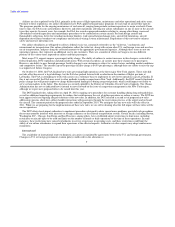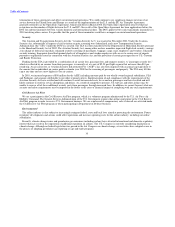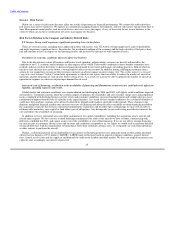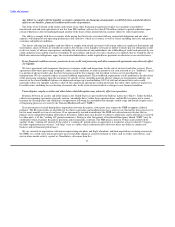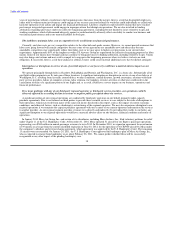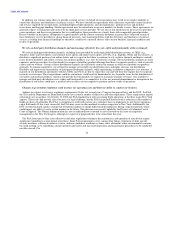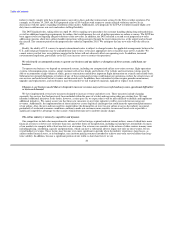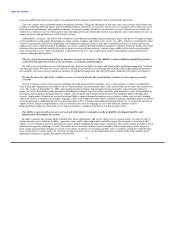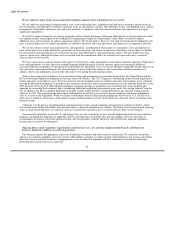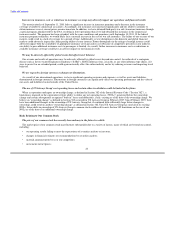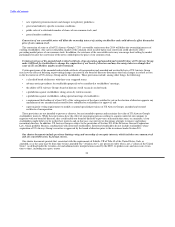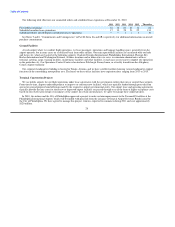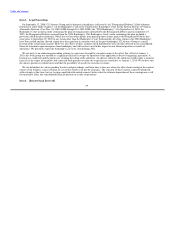US Airways 2010 Annual Report Download - page 20
Download and view the complete annual report
Please find page 20 of the 2010 US Airways annual report below. You can navigate through the pages in the report by either clicking on the pages listed below, or by using the keyword search tool below to find specific information within the annual report.
Table of Contents
In addition, our reliance upon others to provide essential services on behalf of our operations may result in our relative inability to
control the efficiency and timeliness of contract services. We have entered into agreements with contractors to provide various facilities
and services required for our operations, including Express flight operations, aircraft maintenance, ground services and facilities,
reservations and baggage handling. Similar agreements may be entered into in any new markets we decide to serve. These agreements are
generally subject to termination after notice by the third-party service provider. We are also at risk should one of these service providers
cease operations, and there is no guarantee that we could replace these providers on a timely basis with comparably priced providers.
Recent volatility in fuel prices, disruptions to capital markets and the current economic downturn in general have subjected certain of
these third-party service providers to strong financial pressures. Any material problems with the efficiency and timeliness of contract
services, resulting from financial hardships or otherwise, could have a material adverse effect on our business, financial condition and
results of operations.
We rely on third party distribution channels and must manage effectively the costs, rights and functionality of these channels.
We rely on third party distribution channels, including those provided by or through global distribution systems, or GDSs (e.g.,
Amadeus, Sabre and Travelport), conventional travel agents and online travel agents, or OTAs (e.g., Expedia, Orbitz and Travelocity), to
distribute a significant portion of our airline tickets and we expect in the future to continue to rely on these channels and hope eventually
to use them to distribute and collect revenues for ancillary products (e.g., fees for selective seating). These distribution channels are more
expensive and at present have less functionality in respect of ancillary product offerings than those we operate ourselves, such as our call
centers and our website. Certain of these distribution channels also effectively restrict the manner in which we distribute our products
generally. To remain competitive, we will need to manage successfully our distribution costs and rights, increase our distribution
flexibility and improve the functionality of third party distribution channels, while maintaining an industry-competitive cost structure. A
majority of our distribution agreements with key GDSs and OTAs are due to expire this year and will therefore require that we negotiate
renewals or extensions. These negotiations could be contentious, could result in diminished or less favorable terms for the distribution of
our tickets and ancillary products, and may not provide the functionality we require to maximize ancillary revenues. Any inability to
manage our third party distribution costs, rights and functionality at a competitive level or any material diminishment or disruption in the
distribution of our tickets could have a material adverse effect on our competitive position and our results of operations.
Changes in government regulation could increase our operating costs and limit our ability to conduct our business.
Airlines are subject to extensive regulatory requirements. In the last several years, Congress has passed laws, and the DOT, the FAA,
the TSA and the Department of Homeland Security have issued a number of directives and other regulations. These requirements impose
substantial costs on airlines. On October 10, 2008, the FAA finalized new rules governing flight operations at the three major New York
airports. These rules did not take effect because of a legal challenge, but the FAA has pushed forward with a reduction in the number of
flights per hour at LaGuardia. The FAA is attempting to work with carriers on a voluntary basis to implement its new lower operations
cap at LaGuardia. If this is not successful, the FAA may resort to other methods to reduce congestion in New York. Additionally, the
DOT recently finalized a policy change that will permit airports to charge differentiated landing fees during congested periods, which
could impact our ability to serve certain markets in the future. This decision was recently upheld by the District of Columbia Circuit
Court of Appeals. The Obama Administration has not yet indicated how it intends to move forward on the issue of congestion
management in the New York region, although we expect new proposed rules to be issued later this year.
The FAA from time to time issues directives and other regulations relating to the maintenance and operation of aircraft that require
significant expenditures or operational restrictions. Some FAA requirements cover, among other things, retirement of older aircraft,
security measures, collision avoidance systems, airborne windshear avoidance systems, noise abatement, other environmental concerns,
fuel tank inerting, crew scheduling, aircraft operation and safety and increased inspections and maintenance procedures to be conducted
on older aircraft. Our
19


